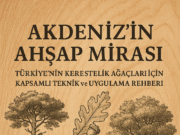Ecological Footprint, A concept and methodology developed by the Global Footprint Network as a key sustainability indicator used to measure human impact on ecosystems on the planet.
This indicator examines the balance between the demand created by human activities on nature and the supply of natural resources. The analysis of the relationship between demand and supply reveals whether natural resources are used within the limit of self-renewal, and provides the opportunity to establish a scientific basis for effective and applicable solutions to eliminate this imbalance.
Ecological Footprint Calculation
In ecological footprint calculations supply of natural resources or natural capital "biological capacity", if the demand on nature "ecological footprint" explained with concepts. Biocapacity of a geographic area renewable natural resourcesIt shows the production capacity. The factors that determine the biological capacity of a place are basically divided into two:
the area of agricultural land, grazing land, fishing grounds and forest areas within the boundaries of the area, and how productive the land or water in question is. Biocapacity is calculated in terms of area and expressed in “global hectares” (kha).
Küresel hektar, dünyanın ortalama verimliliği üzerinden 1 hektar arazinin üretim kapasitesini temsil ediyor. Ekolojik ayak izi ise mevcut teknoloji ve kaynak yönetimiyle bir bireyin, topluluğun ya da faaliyetin tükettiği kaynakları üretmek ve yarattığı atığı bertaraf etmek için gereken biyolojik olarak verimli toprak ve su alanını ifade ediyor. Ekolojik Ayak İzi de “küresel hektar” (kha) ile ifade ediliyor. Ayak izi kapsamına altyapı ile atık karbondioksitin (CO2 ) emilimini sağlayacak bitki örtüsü için gerekli alanlar da dahil ediliyor. Karbon ayak izi, tarım arazisi ayak izi, orman ayak izi, otlak ayak izi, yapılaşmış alan ayak izi ve balıkçılık sahası ayak izi, ekolojik ayak izinin bileşenleri olarak tanımlanıyor. Küresel ekolojik ayak izinin en hızlı büyüyen bileşeni olan karbon ayak izi, toplam ayak izinin %60’ından fazlasını oluşturuyor. Ekolojik ayak izi analizinde, tüketimin ve üretimin ekolojik ayak izi arasındaki fark önem arz ediyor.
footprint of consumption It refers to the pressure on nature to produce products consumed by a person or a community. The fact that the per capita consumption footprint exceeds the biocapacity per capita on a global scale indicates that the planet will be subject to a permanent overshoot if the consumption pattern is reflected on the global scale.
The ecological footprint of production provides information on the use of biocapacity provided from a country or a geographical region. The footprint of production at any scale biocapacity means that the natural resources there are used in an unsustainable way.
2007 verilerine göre küresel ölçekte tüketimin ekolojik ayak izi toplam 20,1 milyar, kişi başına ise 2,8 kha düzeyinde idi. Aynı yıl için biyolojik kapasite toplam 12,2 milyar, kişi başına ise 1,7 kha olarak gerçekleşti.2 Bu veriler, ekolojik ayak izinin biyolojik kapasiteyi %65’e ulaşan bir oranda aştığını gösteriyor. Bunun sonucunda, gezegenin bir yıl içinde sunabileceği kaynakları ne zaman aştığımızı gösteren World Overshoot Day It coincides with the month of August, when we leave behind three-fifths of the year. It is calculated that the ecological footprint per capita in Turkey is at the level of 3.3 kha per year, and our national biocapacity per capita is at the level of 1.5 kha, below the world average, according to 2012 data.
Bu değerlendirme, kişi başına ekolojik ayak izimizin küresel kapasitenin %90, ulusal kapasitemizin ise %120’nin üzerinde olduğunu, Türkiye’nin mevcut ekolojik ayak izini karşılayabilmek için iki Türkiye’den biraz daha fazlasına ihtiyaç duyduğumuzu gösteriyor.
Ecological Footprint of Production
It refers to the use of biocapacity provided from a country or a geographical region. A local/national/global comparison of this indicator with the available biocapacity within the same area is easy. sustainability it is possible to obtain the criterion: the production Ecological FootprintExceeding biocapacity means that the natural resources there are used in an unsustainable manner.
Biological Capacity
It is an indicator of the capacity of a geographical region to produce renewable natural resources. Two factors determine the biocapacity of a place: the area of farmland, grassland, fishing ground, and forest within its boundaries, and how productive that land or water is. Like the Ecological Footprint, biocapacity is calculated in terms of area and expressed in “global hectares” (kha).
| Footprint Components Definitions | Situation in Turkey | |
| Carbon Capture Footprint Calculation of forest area required to capture emissions from fossil fuel consumption, land use changes and chemical processes, as well as CO2 emissions captured by the oceans. | Türkiye’nin toplam Ekolojik Ayak İzi’nin en büyük paydası %46-49’la (kişi başı 1,24-1,36 kha) CO2 emisyonlarını hapsetmek için gerekli talepten kaynaklanır. 1961 – 2007 yılları arasında tüm arazi kategorilerindeki Ayak İzi’nde büyüme olmuş, ancak en fazla artış Karbon Ayak İzi’nde ortaya çıkmıştır. | |
| Farmland Footprint It is the calculation of the area used for the production of food and fibre, animal feed, oil crops and rubber required for human consumption. | Türkiye’nin Ekolojik Ayak İzi’nin yaklaşık %35’i tarım alanlarına yönelik talepten kaynaklanır (kişi başı yaklaşık 0,96 kha). Tarım Ayak İzi’nin büyük kısmı (%83) gıdayla ilişkilidir. Geri kalan kısım ise çoğunlukla tütün üretimi ve devlet harcamalarından kaynaklanır. | |
| Forest Footprint It is the calculation of the forest area required to meet the amount of logging/lumber, pulp, wood products and firewood consumed. | Türkiye’nin orman ürünlerine yönelik talebi ulusal Ayak İzi’nin %11’ini (kişi başı 0,29 kha) oluşturur. 1961 yılı ile 2007 yılı arasında en az büyüme Orman Ayak İzi’nde gerçekleşmiştir. | |
| Grassland Footprint It is the calculation of the livestock area for meat, milk, leather and wool products. | Grazing land use in Turkey constitutes %3 of the national Footprint (0.08 kha per capita). | |
| Built Area Footprint It is the calculation of the area covered with infrastructure and superstructure related to meeting human needs including housing, transportation, industrial structures and power plants. | Built-up land use accounts for %3 of the total Footprint and is 0.07 global hectares per capita. |
Footprintnetwork.org
Source: Sustainability Guide, footprintnetwork






























